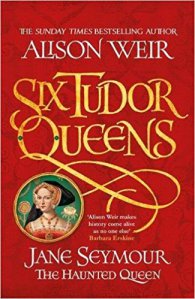
Six Tudor Queens: Jane Seymour – The Haunted Queen, by Alison Weir, is the third in a series of specially commissioned books which together tell the story of Henry VIII’s wives, from their point of view. Each instalment is a highly detailed, fictionalised account based on known and researched facts, with literary licence taken to aid storytelling. The author is a well regarded historian and explains at the end of each book why she presented key moments in her subjects’ lives the way she did. Jane Seymour served both Katherine of Aragon and Anne Boleyn as a maid-of-honour during the turbulent years when the latter replaced the former as queen so there is a degree of overlap in the first three books in the series. Jane left little written evidence of her life and thoughts so the author has constructed a tale based on interpretation and informed invention.
The story opens when Jane is ten years old and attending a lavish dinner at her family home, Wulf Hall in Wiltshire, to celebrate the marriage of her elder brother, Edward, to Catherine Fillol. The match is regarded as a good one by both families and within a year they have had a child. By then their initial happiness has soured for disturbing reasons. Jane’s mother gave birth to ten children but not all survived into adulthood. The precariousness of life, at a time when doctors could offer little more than herbal infusions as remedies, plays a key role in the ongoing narrative. The coming years bring outbreaks of devastating plague to England as well as the tragedies of royal babies not carried to term. The fecundity of the Seymours may well have been part of Jane’s appeal to the king when he grew disillusioned with Anne Boleyn.
The timeline jumps forward to when Jane is eighteen years old. She wishes to be a nun but does not cope well with the hardships required by this life so returns home. Her siblings are making their way in the world and she starts to look beyond Wulf Hall which is no longer the happy, family home of her childhood. She is pleased to be granted the opportunity to serve at the royal court in London.
Jane soon discovers that court life is a hotbed of intrigue and gossip, the factional rivalry an unwelcome contrast to the peaceful existence she associates with Wulf Hall. Anne is approaching her zenith and Jane accompanies Katherine when she is required to leave Henry and his palaces as the royal marriage is annulled. Jane is a staunch supporter of the church so is appalled by the ecclesiastical reforms being proposed and managed by an increasingly influential Cromwell. When Katherine is stripped of her household in an attempt to force her to comply with the king’s wishes, the Seymours insist that Jane not waste the costly court place they provided. She is required to return to London and serve Anne.
Jane is witness to the distress caused by the new queen’s miscarriages. Despite Anne’s suffering, Jane despises her for what she has done to Katherine. When Henry starts to take notice of Jane she chooses not to reject his advances as she does not consider him lawfully married. In this she is encouraged by her ambitious brothers and a growing band of supporters eager to do away with Anne and reinstate Katherine’s daughter, Mary, in the succession.
The bare bones of the story are, of course, well known. In many ways the plot is slow moving as Jane’s participation and influence on key events are minor until close to the end of her life. What this enables is a detailed portrayal of life in Tudor England from the point of view of a noble but peripheral family rising through the echelons of the royal court. Clothes, food, and the day to day preoccupations of sixteenth century, privileged women are vividly presented.
Jane is depicted as somewhat gauche but aware of the risks she is taking in becoming involved with Henry. Her loyalty to her family is key in the decisions she makes. Having witnessed how ruthless Henry could be to his wives she is aware of the precariousness of her position. Although wishing to promote the causes her supporters espouse she is mostly circumspect in her dealings with the king who has little patience with any who will not bend as he wills.
The author has chosen not to ascribe Jane’s death to the traditionally accepted puerperal fever. Her reasoning for this is compelling. By this time Henry was approaching fifty, suffering from leg ulcers and putting on weight. The couple’s supposed love for each other is shown to have serious caveats. It seems unlikely that the life Jane dreamed of would have been possible even had she lived.
Although the truly historic events are the same in all three of the books so far released in this series, the changing points of view provide new perspective and depth. This is an accessible and well structured account of a queen who, despite providing Henry’s longed for prince, is rarely granted as much attention as her predecessor. It provides an intimate window into the rarefied yet ruthless Tudor world.
My copy of this book was provided gratis by the publisher, Headline.
Advertisements Share this:




